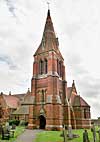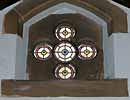For this church:    |
|
Key to Glass |
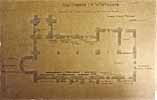 Stained glass Stained glass windows plan |
A ‘Scheme for filling in windows with Stained Glass’ was submitted by Messrs. Heaton, Butler and Bayne, presumably at the time the church was being built in 1886-8. Although many of the themes suggested do exist in the windows we see today, they are not necessarily in the positions originally marked, and some were never installed.
North Aisle (North wall)
Although subjects had apparently been decided for all five single-light, arched windows along the north aisle, the consecration booklet does not mention any of them. It seems likely, then, that at the time of Consecration, all of these windows would have been filled with plain, coloured glass, as per window 5 on the plan.
1.Saint Christopher window
 |
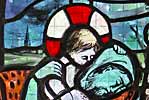 Detail showing Newark Detail showing Newarkchurch in the background |
In 1889 a stained glass window was installed by the gift of the Bishop of Southwell. The glass represented St George, patron saint of England, treading the dragon underfoot and underneath read the inscription ‘Offered by George, Lord Bishop of Southwell’. The window, like other stained glass windows in the church, was completed by the studios of Heaton, Butler and Bayne of Garrick Street, London.
Unfortunately, this window was damaged by vandals, and in 1983 a new window, depicting St. Christopher carrying the Christ child across a river, was commissioned from the artist Bronwen Gordon, whose name is in the bottom left hand corner. A small sketch of Newark St Mary Magdalene appears to the left of the Christ child’s head, and the following words are inscribed near the bottom of the piece:
| Saint CHRISTOPHER |
2.The Allwood window
 The subject of this window is St. Hugh (1140-1200), who was made Bishop of Lincoln in 1186 by King Henry II and immediately started to rebuild the Cathedral after it had been destroyed by a giant earthquake the previous year. In the window St. Hugh is depicted wearing a mitre and holding a crosier and a model of Lincoln Cathedral with a white swan at his feet. The swan, which became his emblem, is a reference to the story of the great swan of Stowe which contracted a deep and lasting friendship for the saint, even guarding him while he slept. Better known as St. Hugh of Lincoln, he is the Patron saint of sick children, sick people and swans.
The subject of this window is St. Hugh (1140-1200), who was made Bishop of Lincoln in 1186 by King Henry II and immediately started to rebuild the Cathedral after it had been destroyed by a giant earthquake the previous year. In the window St. Hugh is depicted wearing a mitre and holding a crosier and a model of Lincoln Cathedral with a white swan at his feet. The swan, which became his emblem, is a reference to the story of the great swan of Stowe which contracted a deep and lasting friendship for the saint, even guarding him while he slept. Better known as St. Hugh of Lincoln, he is the Patron saint of sick children, sick people and swans.
The entire window is fitted as a hopper-style opening panel and is inscribed at the top:
| S. HUGH B. |
The non-abbreviated form of the inscription is 'Saint Hugh Bishop'.
At the bottom of the window are inscribed the words:
| A.M.D.G. et Sac. Mem. Edward Allwood, ob. July 21, 1928 The gift of his children. |
'A.M.D.G. et Sac. Mem.' is the abbreviation for the Latin 'Ad Majorem Dei Gloriam et Sacra Memoriae'. This can be translated as 'For the Greater Glory of God and in Sacred Memory of'. The abbreviation 'ob.' is short for the Latin 'obiit', meaning 'died'.
The window is signed 'W LAWSON', presumably William Lawson (1892-1946) who was a designer with the Faith Craft Works.
Edward Allwood was buried in the churchyard at Winthorpe on 24 July 1928, aged 80.
3.St. Francis of Assisi window
 The original subject of this window was Abraham, the first Patriarch of the Jewish people, but unfortunately it was damaged and subsequently replaced in 1989, by another piece from the artist Bronwen Gordon, signed in the bottom left hand corner. The subject of this new window is St. Francis, 1182-1226, who is the Patron saint of animals, birds and the environment. He was born in the town of Assisi, Italy and is the founder of the religious Franciscan Order. The window depicts St. Francis dressed as a monk wearing sandals, a rope around his waist and surrounded by animals and birds.
The original subject of this window was Abraham, the first Patriarch of the Jewish people, but unfortunately it was damaged and subsequently replaced in 1989, by another piece from the artist Bronwen Gordon, signed in the bottom left hand corner. The subject of this new window is St. Francis, 1182-1226, who is the Patron saint of animals, birds and the environment. He was born in the town of Assisi, Italy and is the founder of the religious Franciscan Order. The window depicts St. Francis dressed as a monk wearing sandals, a rope around his waist and surrounded by animals and birds.
Below the window is a brass plaque. Presumably referring to the original window, it is in memory of Frances Christina Handley, a sister of the Revd. Edward Handley, who funded the building of the church:
| IN MEMORY OF THE SISTER FRANCES CHRISTINA OF THE COMMUNITY OF ALL SAINTS AND PREVIOUSLY OF ST GEORGE’S HOME, CAPE TOWN. DIED MARCH 3RD 1895. |
4.The Kelk window
 This window depicts the miracle of Jesus walking on water, recounted in three of the Gospels: Matthew 14:22-33, Mark 6:45-52 and John 6:16-21.
This window depicts the miracle of Jesus walking on water, recounted in three of the Gospels: Matthew 14:22-33, Mark 6:45-52 and John 6:16-21.
Below the window is a brass plaque to Helen Jane Kelk, who died 13 July 1890 at Cromer, Norfolk, and was buried in the churchyard at Winthorpe four days later:
| IN AFFECTIONATE REMEMBRANCE OF HELEN JANE KELK BY A.S.P-D., E.S.P-D. AND G.S.P-D. She 'being dead yet speaketh'. Heb. 11. 4. |
The owners of the initials are most likely to be three daughters of George Thomas Peirse-Duncombe and his wife Arabella Georgina, who lived at Winthorpe Hall, and with whom Helen Jane Kelk had been residing as a visitor in 1881. Their names are Arabella, Elizabeth and Georgiana; the initial S standing for Slingsby after their grandfather, Slingsby Duncombe of Langford.
Behind the organ
Chancel
All the stained glass in the chancel was installed at the time the church was built, by Messrs. Heaton, Butler and Bayne. The east window (9) is triple lancet, the centre lancet being taller than the other two. The three windows (10, 11 & 12) on the south wall of the chancel are single lancets with pointed trefoil heads, surmounted by a trefoil and eyelets.
9.The East Window
 Proposed layout of Proposed layout of the All Saints window |
An extract from the Consecration service booklet reads: 'The east window is the gift of Mrs. Edward Gordon, daughter of a late rector of the parish, and represents our Lord reigning in glory surrounded by His Saints'. The names of the saints are detailed on the diagram on the right.
The only inscription on this window is in the centre lancet, on a banner below the figure of Christ, and reads:
| Blessing, Honour, Glory and Power |
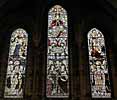 East window East window |
Mrs. Edward Gordon was in fact Louisa Handley, daughter of the Revd. William Handley who had been rector of the church from 1836 to 1873. He was the third son of John and Martha Handley, whose memorials are in the vestry, brother of Philip Handley, in whose memory the church was built, and second cousin to the Revd. Edward Handley.
Kelly’s directory for 1881 states that 'the east window is a memorial to Cassandra Handley, and was erected in 1859'. Given the date of the directory, this refers to the east window in the previous church, and can be seen in the photograph of the old interior here. Cassandra Handley was the wife of the Revd. Charles Richard Handley, fourth and youngest son of William and Ann Handley. He was buried at Herne Hill, Kent, but the memorials to his brothers are in the vestry at Winthorpe.
10.The Caroline Handley window
![]() This window is situated above the sedilia, and its subject is the Blessed Virgin and Child. The inscription at the bottom of the window is:
This window is situated above the sedilia, and its subject is the Blessed Virgin and Child. The inscription at the bottom of the window is:
THE WORD WAS MADE FLESH |
There is a brass plaque below the window, in memory of the Revd. Edward Handley’s mother:
IN FILIAL MEMORY OF |
11.The Sister Laura Handley window
![]() This window is situated in the choir, and its subject is Jesus appearing to Mary Magdalene after his Resurrection, recounted in John 20:16. The inscription on the window beneath the figures is 'RABBONI', which was a Jewish title of respect meaning master or teacher.
This window is situated in the choir, and its subject is Jesus appearing to Mary Magdalene after his Resurrection, recounted in John 20:16. The inscription on the window beneath the figures is 'RABBONI', which was a Jewish title of respect meaning master or teacher.
There is a brass plaque below the window, in memory of the Revd. Edward Handley’s sister:
IN MEMORY OF |
12.The Georgiana Handley window
![]() This window is also situated in the choir, and its subject is Jesus washing the Disciples’ feet at the Last Supper, recounted in John 13:1-17. The inscription on the window beneath the figures is
This window is also situated in the choir, and its subject is Jesus washing the Disciples’ feet at the Last Supper, recounted in John 13:1-17. The inscription on the window beneath the figures is
| JESUS WASHED THE DISCIPLES FEET |
There is a brass plaque below the window, in memory of another of the Revd. Edward Handley’s sisters:
| IN MEMORY OF GEORGIANA HANDLEY, OF ST GEORGES HOME CAPE TOWN DIED DECEMBER 14 1874 |
Nave
The three windows on the south wall are pairs of lancets with a cinquefoil above. The centre pane of each cinquefoil depicts an angel carrying a banner with the word 'ALLELVIA' inscribed on it, and in windows (13) and (14) this pane rotates horizontally to provide ventilation. These two windows were also installed when the church was built, and are by Messrs. Heaton, Butler and Bayne.
13.The Gilstrap window
 The subject of the left hand lancet is the Raising of Lazarus, recounted in John 11:1-46. The inscription beneath the figures is:
The subject of the left hand lancet is the Raising of Lazarus, recounted in John 11:1-46. The inscription beneath the figures is:
| I AM THE RESVRRECTION AND THE LIFE JOHN XI:25 |
The subject of the right hand lancet is the Woman of Samaria, recounted in John 4:4-26. The inscription beneath the figures is:
| WHOSOEVER DRINKETH OF THE WATER THAT I SHALL GIVE HIM SHALL NEVER THIRST JOHN IV:14 |
The memorial inscription at the bottom of the two lancets is divided between them as follows:
|
George Gilstrap was from a notable Newark family of maltsters, whose wife and children, after his death, came to the village and lived in Winthorpe House. G. Hemingway’s 'The Gilstraps of Newark' has this to say about the circumstances of his death:
'On Monday 26-12-1864 he was waiting for a train at Balham Station, London, on the Victoria & Croydon Railway, when he was knocked down by an express and died two hours later, aged 42, in St. George’s Hospital'.
He was buried on Monday, 2 January, at Newark Borough Cemetery, his body being brought by train to Northgate railway station. Nearly 1,000 people were present at the funeral and tradesmen of the town closed their shops from 12 noon until 2pm as a mark of respect.
George was the youngest son of Joseph Gilstrap, well-known hotelier, wine merchant and alderman of Newark, and his wife Elizabeth. There is a window in Newark St Mary Magdalene to the memory of Elizabeth.
14.The Branston window
 The subject of the left hand lancet is Martha and Mary Magdalene. The inscription beneath the figures is:
The subject of the left hand lancet is Martha and Mary Magdalene. The inscription beneath the figures is:
| MARY HATH CHOSEN THAT GOOD PART LVKE X:42 |
The subject of the right hand lancet is the Last Supper. The inscription beneath the figures is:
| JESVS TOOK BREAD & BLESSED IT MARK XIV:22 |
The memorial inscription at the bottom of the two lancets is divided between them as follows:
| TO THE GLORY OF GOD AND IN LOVING MEMORY OF JOSEPH WILLIAM AND ELIZABETH[GILSTRAP]BRANSTON THIS WINDOW IS ERECTED BY THEIR CHILDREN 1888 |
Like the Gilstraps, the Branstons were another well-known family of Newark maltsters. Joseph William Branston’s wife Elizabeth was the daughter of Joseph and Elizabeth Gilstrap, and sister of George – see window 13 above. Joseph William Branston, maltster and seed merchant, died on 28 May 1859 at Newark. A few years after his death, Elizabeth moved to the village and lived in Winthorpe Grange. She died there on 27 October 1873, and is buried with her husband Joseph William in Newark Cemetery.
15.The Ward memorial window
 |
 |
The subject of the left hand lancet is the Nativity. The inscription beneath the figures is:
| God was manifest in the flesh |
The subject of the right hand lancet is the Presentation of Christ at the Temple, recounted in Luke 2:22-40. The inscription beneath the figures is:
| Lord now lettest thou thy servant depart in peace |
The memorial inscription at the bottom of the two lancets is divided between them as follows:
| To the Glory of God and in loving memory of Eliza Ward of Winthorpe who died Dec 31st 1891 this window is erected by her niece Margaret Myers |
Eliza Ward was the daughter of a family of master cutlers in Sheffield. When she died, she bequeathed a silhouette drawing of John Harrison Esq. to her niece Margaret Myers. John Harrison was her mother’s uncle and had been the Purser on Captain Wallis’ ship the 'Dolphin' when they discovered Otaheite (Tahiti) in 1767. Miss Ward was buried in the churchyard at Winthorpe on 2 January 1892, aged 77.
Baptistry
In the baptistry there are three lancet windows installed by Messrs. Heaton, Butler and Bayne at the time the church was built.
16.The Good Shepherd window
![]() The subject of this window is the Good Shepherd, as recounted in John 10:11-18.
The subject of this window is the Good Shepherd, as recounted in John 10:11-18.
The inscription on the window is:
I AM THE GOOD |
North Aisle (west wall)
19.The Ward thank-offering window
![]() The subject of this arched window is the Transfiguration of Jesus, as recounted in Matthew 17:1-9, Mark 9:2-8 and Luke 9:28-36.
The subject of this arched window is the Transfiguration of Jesus, as recounted in Matthew 17:1-9, Mark 9:2-8 and Luke 9:28-36.
The inscription on the window is:
| THIS IS MY BELOVED SON IN WHOM I AM WELL PLEASED MATT XVII:5 |
This window was intended to have been installed before the Consecration service, and was presumably installed shortly after – it is believed to have been designed by Messrs. Heaton, Butler and Bayne.
Below the window, the gift of Miss Eliza Ward (see window 15), is fixed a small brass plaque:
| TO THE GLORY OF GOD A THANK-OFFERING FROM E. WARD. A.D. 1888 |
Porch
Tower stairs and ringing room
There is a small arched window on the west wall of the stairs, and lancet windows on all sides of the ringing room except for the south wall, all being plain, coloured glass. The east and west windows in the ringing room contain hopper-style opening panels near the top.


